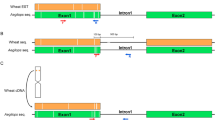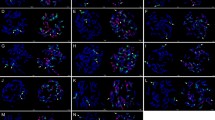Abstract
Introgression from allohexaploid wheat (Triticum aestivum L., AABBDD) to allotetraploid jointed goatgrass (Aegilops cylindrica Host, CCDD) can take place in areas where the two species grow in sympatry and hybridize. Wheat and Ae. cylindrica share the D genome, issued from the common diploid ancestor Aegilops tauschii Coss. It has been proposed that the A and B genome of bread wheat are secure places to insert transgenes to avoid their introgression into Ae. cylindrica because during meiosis in pentaploid hybrids, A and B genome chromosomes form univalents and tend to be eliminated whereas recombination takes place only in D genome chromosomes. Wheat random amplified polymorphic DNA (RAPD) fragments, detected in intergeneric hybrids and introgressed to the first backcross generation with Ae. cylindrica as the recurrent parent and having a euploid Ae. cylindrica chromosome number or one supernumerary chromosome, were assigned to wheat chromosomes using Chinese Spring nulli-tetrasomic wheat lines. Introgressed fragments were not limited to the D genome of wheat, but specific fragments of A and B genomes were also present in the BC1. Their presence indicates that DNA from any of the wheat genomes can introgress into Ae. cylindrica. Successfully located RAPD fragments were then converted into highly specific and easy-to-use sequence characterised amplified regions (SCARs) through sequencing and primer design. Subsequently these markers were used to characterise introgression of wheat DNA into a BC1S1 family. Implications for risk assessment of genetically modified wheat are discussed.


Similar content being viewed by others
References
Abranches R, Santos AP, Wegel E, Williams S, Castilho A, Christou P, Shaw P, Stoger E (2000) Widely separated multiple transgene integration sites in wheat chromosomes are brought together at interphase. Plant J 24:713–723
Badaeva ED, Amosova AV, Muravenko OV, Samatadze TE, Chikida NN, Zelenin AV, Friebe B, Gill BS (2002) Genome differentiation in Aegilops. 3 Evolution of the D-genome cluster. Plant Syst Evol 231:163–190
Cadalen T, Boeuf C, Bernard S, Bernard M (1997) An intervarietal molecular marker map in Triticum aestivum L. Em. Thell. and comparison with a map from a wide cross. Theor Appl Genet 94:367–377
Devos KM, Gale MD (1992) The use of random amplified polymorphic DNA markers in wheat. Theor Appl Genet 84:567–572
Donald WW, Ogg AG (1991) Biology and control of jointed goatgrass (Aegilops cylindrica), a review. Weed Technol 5:3–17
Ellstrand NC (2003) Dangerous liaisons? When cultivated plants mate with their wild relatives. In: Scheiner SM (ed) Syntheses in ecology and evolution. The Johns Hopkins University Press, Baltimore, pp 26–49
Gale MD, Miller TE (1987) The introduction of alien genetic variation in wheat. In: Lupton FGH (ed) Wheat breeding Its scientific bases. Chapman and Hall, London New York, pp 173–210
Guadagnuolo R, Savova-Bianchi D, Felber F (2001) Gene flow from wheat (Triticum aestivum L) to jointed goatgrass (Aegilops cylindrica Host), as revealed by RAPD and microsatellite markers. Theor Appl Genet 103:1–8
Hegde SG, Waines JG (2004) Hybridization and introgression between bread wheat and wild and weedy relatives in North America. Crop Sci 44:1145–1155
Hernandez P, Martin A, Dorado G (1999) Development of SCARs by direct sequencing of RAPD products: a practical tool for the introgression and marker-assisted selection of wheat. Mol Breed 5:245–253
Hernandez P, de la Rosa R, Rallo L, Dorado G, Martin A (2001) Development of SCAR markers in olive (Olea europaea) by direct sequencing of RAPD products: applications in olive germplasm evaluation and mapping. Theor Appl Genet 103:788–791
Jackson SA, Zhang P, Chen WP, Phillips RL, Friebe B, Muthukrishnan S, Gill BS (2001) High-resolution structural analysis of biolistic transgene integration into the genome of wheat. Theor Appl Genet 103:56–62
Janakiraman V, Steinau M, McCoy SB, Trick HN (2002) Recent advances in wheat transformation. In Vitro Cell Dev Biol Plant 38:404–414
Kroiss LJ, Tempalli P, Hansen JL, Vales MI, Riera-Lizarazu O, Zemetra RS, Mallory-Smith CA (2004) Marker-assessed retention of wheat chromatin in wheat (Triticum aestivum) by jointed goatgrass (Aegilops cylindrica) backcross derivatives. Crop Sci 44:1429–1433
Lin Y (2001) Risk assessment of bar gene transfer from B and D genomes of transformed wheat (Triticum aestivum) lines to jointed goatgrass (Aegilops cylindrica). J Anhui Agric Univ 28:115–118
Lukaszewski AJ (2000) Manipulation of the 1RS.1BL translocation in wheat by induced homoeologous recombination. Crop Sci 40:216–225
Metz PLJ, Jacobsen E, Nap JP, Pereira A, Stiekema WJ (1997) The impact on biosafety of the phosphinothricin-tolerance transgene in inter-specific B rapa × B napus hybrids and their successive backcrosses. Theor Appl Genet 95:442–450
Morrison LA, Crémieux L, Mallory-Smith CA (2002a) Infestations of jointed goatgrass (Aegilops cylindrica) and its hybrids in Oregon wheat fields. Weed Sci 50:737–747
Morrison LA, Riera-Lizarazu O, Crémieux L, Mallory-Smith CA (2002b) Jointed goatgrass (Aegilops cylindrica Host) × wheat (Triticum aestivum L) hybrids: hybridization dynamics in Oregon wheat fields. Crop Sci 42:1863–1872
Nelson JC, Sorrells ME, Vandeynze AE, Lu YH, Atkinson M, Bernard M, Leroy P, Faris JD, Anderson JA (1995) Molecular mapping of wheat - major genes and rearrangements in homoeologous group-4, group-5, and group-7. Genetics 141:721–731
Okamoto M (1957) Asynaptic effect of chromosome V. Wheat Inf Ser 5:6
Paillard S, Schnurbusch T, Winzeler M, Messmer M, Sourdille P, Abderhalden O, Keller B, Schachermayr G (2003) An integrative genetic linkage map of winter wheat (Triticum aestivum L). Theor Appl Genet 107:1235–1242
Paran I, Michelmore RW (1993) Development of reliable PCR-based markers linked to downy mildew resistance genes in lettuce. Theor Appl Genet 85:985–993
Rajhathy T (1960) Continuous spontaneous crosses between Aegilops cylindrica and Triticum aestivum. Wheat Inf Ser 11:20
Riley R, Chapman V (1958) Genetic control of cytologically diploid behaviour of hexaploid wheat. Nature 182:713–715
Salvo-Garrido H, Travella S, Bilham LJ, Harwood WA, Snape JW (2004) The distribution of transgene insertion sites in barley determined by physical and genetic mapping. Genetics 167:1371–1379
Savova D, Rufener-Al Mazyad P, Felber F (1996) Cytogeography of Medicago falcata L and M sativa L in Switzerland. Bot Helv 106:197–207
Schoenenberger N, Savova-Bianchi D, Guadagnuolo R, Felber F (2005) Gene flow by pollen from wheat to Aegilops cylindrica Host as a function of distance: a field experiment. submitted
Sears ER (1966) Nullisomic-tetrasomic combinations in hexaploid wheat. In: Riley R, Lewis KR (eds) Chromosome manipulations and plant genetics. Oliver and Boyd, London, pp 29–45
Sears ER (1969) Wheat cytogenetics. Annu Rev Genet 3:451–468
Sharma HC (1995) How wide can a wide cross be?. Euphytica 82:43–64
van Slageren MW (1994) Wild wheats: a monograph of Aegilops L and Amblyopyrum (Jaub & Spach) Eig (Poaceae). Wageningen Agricultural University Press, Wageningen; ICARDA, Aleppo
Stewart CN, Halfhill MD, Warwick SI (2003) Transgene introgression from genetically modified crops to their wild relatives. Nat Rev Genet 4:806–817
Svitashev S, Ananiev E, Pawlowski WP, Somers DA (2000) Association of transgene insertion sites with chromosome rearrangements in hexaploid oat. Theor Appl Genet 100:872–880
Wang ZN, Hang A, Hansen J, Burton C, Mallory-Smith CA, Zemetra RS (2000) Visualization of A- and B-genome chromosomes in wheat (Triticum aestivum L) × jointed goatgrass (Aegilops cylindrica Host) backcross progenies. Genome 43:1038–1044
Zemetra RS, Hansen J, Mallory-Smith CA (1998) Potential for gene transfer between wheat (Triticum aestivum) and jointed goatgrass (Aegilops cylindrica). Weed Sci 46:313–317
Acknowledgments
We are grateful to Prof. Beat Keller and Dr. Nabila Yahiaoui of the Institute of Plant Biology of the University of Zürich, Switzerland, for providing the nulli-tetrasomic wheat lines; to Dr. Eva Stoger of the Institute for Biology of the RWTH Aachen, Germany, for providing seeds of the wheat variety Bobwhite; to Dr. Yong-Ming Yuan and Dr. Philippe Chassot from our laboratory for advice during sequencing, to Anouk Béguin and Sarah Mamie for technical assistance, and to two anonymous reviewers for their helpful comments. This project was funded by the National Centre of Competence in Research (NCCR) Plant Survival, a research programme of the Swiss National Science Foundation.
Author information
Authors and Affiliations
Corresponding author
Additional information
Communicated by B. Friebe
Rights and permissions
About this article
Cite this article
Schoenenberger, N., Felber, F., Savova-Bianchi, D. et al. Introgression of wheat DNA markers from A, B and D genomes in early generation progeny of Aegilops cylindrica Host × Triticum aestivum L. hybrids. Theor Appl Genet 111, 1338–1346 (2005). https://doi.org/10.1007/s00122-005-0063-7
Received:
Accepted:
Published:
Issue Date:
DOI: https://doi.org/10.1007/s00122-005-0063-7




